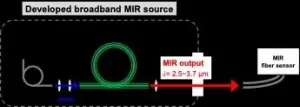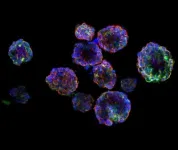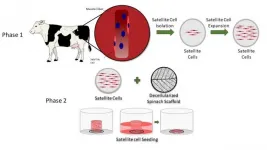Study contributes to our understanding of how cocaine withdrawal affects brain circuits
The results could help clinicians understand addiction and enable people to better manage substance withdrawal
2021-03-31
(Press-News.org) GENEVA, LAUSANNE, 31 March 2021: Cocaine is a highly addictive substance that, in the long term, can have adverse effects on health and wellbeing. There are around 18 million cocaine users globally, according to a UN report. Understanding how cocaine modifies brain networks could reveal potential targets for therapies to treat addiction and other neuropsychological disorders.
A new study published today in the journal Frontiers in Synaptic Neuroscience by a team of researchers from the University of Lausanne and the Wyss Center for Bio and Neuroengineering reveals that during cocaine withdrawal, neurons in a brain area associated with depression connect to neurons embedded in an anti-reward system.
When we receive a reward, neurons fire in the brain's ventral tegmental area (VTA) - a region of the brain that produces dopamine. Dopamine is a chemical messenger that creates feelings of joy or pleasure. It spreads throughout the brain, motivating us to repeat our actions and achieve the feeling of pleasure again, a central facet of addictive behavior.
When we miss out on a reward, or stop taking an addictive drug, the lateral habenula - a brain area linked to depression - becomes hyperactive and sends signals to the VTA that results in depressive symptoms.
What researchers did not know, until now, is exactly where the neurons from the lateral habenula extend into the VTA and what they connect to during withdrawal from cocaine. Through a series of experiments, the team discovered that, in mice, the neurons from the lateral habenula synapse mostly to neurons in the VTA that do not produce dopamine, creating a connection to an anti-reward system that may be key in driving adverse behavior.
Manuel Mameli, PhD, Associate Professor in the Department of Fundamental Neuroscience, University of Lausanne said: "We wanted to understand why individuals experience depression when they stop taking a substance like cocaine. We knew that cocaine withdrawal induces changes to brain circuits linked to depression and reward, but our results have now taken us a step further and show that there is a reorganization of brain circuits that drive negative behavior."
The team combined their expertise in sample preparation and advanced microscopy to capture 3D images of entire intact mouse brains. They used viral 'tags' to make the neurons fluoresce, then created completely transparent samples by removing lipids, before imaging with the Wyss Center's custom-built lightsheet microscope. With data analytics and visualization tools, they identified the 3D morphology of specific neurons to understand their anatomical distribution inside the brain.
Stephane Pages, PhD, Scientific Coordinator at the Wyss Center and Senior Research Associate at the University of Geneva said: "The beauty of lightsheet imaging is being able to see which neurons connect to each other in the brain. Our microscope and data analytics capabilities pinpointed the specific neuronal connections between the two major brain areas implicated in drug withdrawal."
The results of the study also show that neurons in the anti-reward circuits not only project to the VTA but also from there into other parts of the brain resulting in a cascade of 'anti-reward' information into areas responsible for decision making and motivation, amongst others. The next step is to dissect the functionality of these non-dopamine, anti-reward, circuits to better understand how they influence behavior.
INFORMATION:
The paper: Output-specific adaptation of habenula-midbrain excitatory synapses during cocaine withdrawal by Joseph Clerke, Patricia Preston-Ferrer, Ioannis S. Zouridis, Audrey Tissot, Laura Batti,
Fabian F. Voigt, Stéphane Pagès, Andrea Burgalossi and Manuel Mameli is published in Frontiers in Synaptic Neuroscience, doi 10.3389/fnsyn.2021.643138.
Image caption: Neurons from the lateral habenula (green) mostly connect to an anti-reward network of non-dopamine neurons in the VTA. Dopamine neurons are shown in purple. Although there are some connections between the green neurons from the lateral habenula and purple dopamine neurons, these are not the majority.
Image credit: Mameli Lab, University of Lausanne
About the Wyss Center for Bio and Neuroengineering, Geneva, Switzerland
The Wyss Center is an independent, non-profit research and development organization that advances our understanding of the brain to realize therapies and improve lives.
The Wyss Center staff, together with the Center's academic, clinical and industrial collaborators, pursue innovations and new approaches in neurobiology, neuroimaging and neurotechnology.
Wyss Center advances reveal unique insights into the mechanisms underlying the dynamics of the brain and the treatment of disease to accelerate the development of devices and therapies for unmet medical needs.
The Wyss Center was established by a generous donation from the Swiss entrepreneur and philanthropist Hansjörg Wyss in 2014. Additional resources from funding agencies and other sources help the Wyss Center accelerate its mission.
http://www.wysscenter.ch/
MEDIA CONTACTS:
Wyss Center
Jo Bowler, Communications Manager
+41 (0) 58 201 03 09
johanna.bowler@wysscenter.ch
ELSE PRESS RELEASES FROM THIS DATE:
2021-03-31
CLEVELAND, Ohio (March 31, 2021)--Menopause typically signals the end of a woman's ability to become pregnant. However, in a small new study, a novel approach of administering platelet-rich plasma and gonadotropins near the ovarian follicles is showing promise in restoring ovarian function. Study results are published online today in Menopause, the journal of The North American Menopause Society (NAMS).
As more women look to build their careers before pursuing motherhood, the average age of conceiving a child continues to be pushed back. For some of these women, however, their hope of becoming pregnant is cut short by the onset of early menopause, which is described as the cessation of ovarian function ...
2021-03-31
A research team of the National Institutes of Natural Sciences, National Institute for Fusion Science and Akita Prefectural University have successfully demonstrated a broadband mid-infrared (MIR) source with a simple configuration. This light source generates highly-stable broadband MIR beam at 2.5-3.7 μm wavelength range maintaining the brightness owing to its high-beam quality. Such a broadband MIR source facilitates a simplified environmental monitoring system by constructing a MIR fiber-optic sensor, which has the potential for industrial and medical applications.
In the MIR wavelength region, there are many strong absorption lines of molecules ...
2021-03-31
A*STAR's Institute of Bioengineering and Nanotechnology (IBN) has teamed up with Singapore Institute of Advanced Medicine Holdings Pte Ltd (SIAMH) to establish the first of its kind in-vitro patient-derived 3D organoid models of Nasopharyngeal Cancer (NPC).
The study was published in Frontiers in Oncology on 23 February 2021. It is the first direct experimental evidence to predict optimal Radiation Treatment (RT) boost dose required to cause sufficient damage to recurrent hypoxic (low oxygen level) NPC tumour cells, which can be further used to develop dose-painting algorithms in clinical practice.
Two patient-derived xenograft (PDX) ...
2021-03-31
Researchers from Loyola Marymount University, San Diego State University, Indian Institute of Management, and Iowa State University published a new paper in the Journal of Marketing that examines how effective marketplace participation by subsistence consumers requires knowledge and skills that relate to what, how, and why to participate.
The study, forthcoming in the Journal of Marketing, is titled "Marketplace Literacy as a Pathway to a Better World: Evidence from Field Experiments in Low-Access Subsistence Marketplaces" and is authored by Madhu Viswanathan, Nita Umashankar, Arun Sreekumar, and Ashley Goreczny.
Success for marketers looking to emerging markets for growth is inextricably ...
2021-03-31
COLUMBUS, Ohio - Bangladesh's floating gardens, built to grow food during flood seasons, could offer a sustainable solution for parts of the world prone to flooding because of climate change, a new study has found.
The study, published recently in the Journal of Agriculture, Food and Environment, suggests that floating gardens might not only help reduce food insecurity, but could also provide income for rural households in flood-prone parts of Bangladesh.
"We are focused here on adaptive change for people who are victims of climate change, but who did not cause climate ...
2021-03-31
PULLMAN, Wash. -- Nature's strongest material now has some stiff competition. For the first time, researchers have hard evidence that human-made hexagonal diamonds are stiffer than the common cubic diamonds found in nature and often used in jewelry.
Named for their six-sided crystal structure, hexagonal diamonds have been found at some meteorite impact sites, and others have been made briefly in labs, but these were either too small or had too short of an existence to be measured.
Now scientists at Washington State University's Institute for Shock Physics created hexagonal diamonds large enough to measure ...
2021-03-31
Chestnut Hill, Mass. (3/31/21) -- Spinach, a cost-efficient and environmentally friendly scaffold, provided an edible platform upon which a team of researchers led by a Boston College engineer has grown meat cells, an advance that may accelerate the development of cultured meat, according to a new report in the advance online edition of the journal Food BioScience.
Stripped of all but its veiny skeleton, the circulatory network of a spinach leaf successfully served as an edible substrate upon which the researchers grew bovine animal protein, said Boston College Professor of Engineering Glenn Gaudette, the lead author of the new study. The results may help increase the production of cellular agriculture ...
2021-03-31
Research published today in the peer-reviewed Journal of Vertebrate Paleontology describes a newly discovered species of dinosaur - named the 'one who causes fear', or Llukalkan aliocranianus.
Around 80 million years ago as tyrannosaurs ruled the Northern Hemisphere, this lookalike was one of 10 currently known species of abelisaurids flourishing in the southern continents.
A fearsome killer, Llukalkan was "likely among the top predators" throughout Patagonia, now in Argentina, during the Late Cretaceous due to its formidable size (up to five meters long), extremely powerful ...
2021-03-31
Early treatment with anti-VEGF injections slowed diabetic retinopathy in a clinical study from the DRCR Retina Network (DRCR.net). However, two years into the four-year study its effect on vision was similar to standard treatment, which usually begins at the onset of late disease. The intermediate findings published today in the JAMA Ophthalmology. The study was supported by the National Eye Institute (NEI), a part of the National Institutes of Health.
"While it is possible that preventive injections of anti-VEGF drugs may help protect vision in the longer-term, ...
2021-03-31
A new mathematical model suggests that the easing of lockdown must be accompanied by wider and more effective use of control measures such as facemasks even with vaccination, in order to suppress COVID-19 more quickly and reduce the likelihood of another lockdown.
The model, developed by scientists at the Universities of Cambridge and Liverpool, is published today in the Journal of the Royal Society Interface. It uses mathematical equations to provide general insights about how COVID-19 will spread under different potential control scenarios.
Control measures involving facemasks, handwashing and short-scale (1-2 metre) social distancing can all limit the number of virus particles being spread between people. These are termed ...
LAST 30 PRESS RELEASES:
[Press-News.org] Study contributes to our understanding of how cocaine withdrawal affects brain circuits
The results could help clinicians understand addiction and enable people to better manage substance withdrawal



